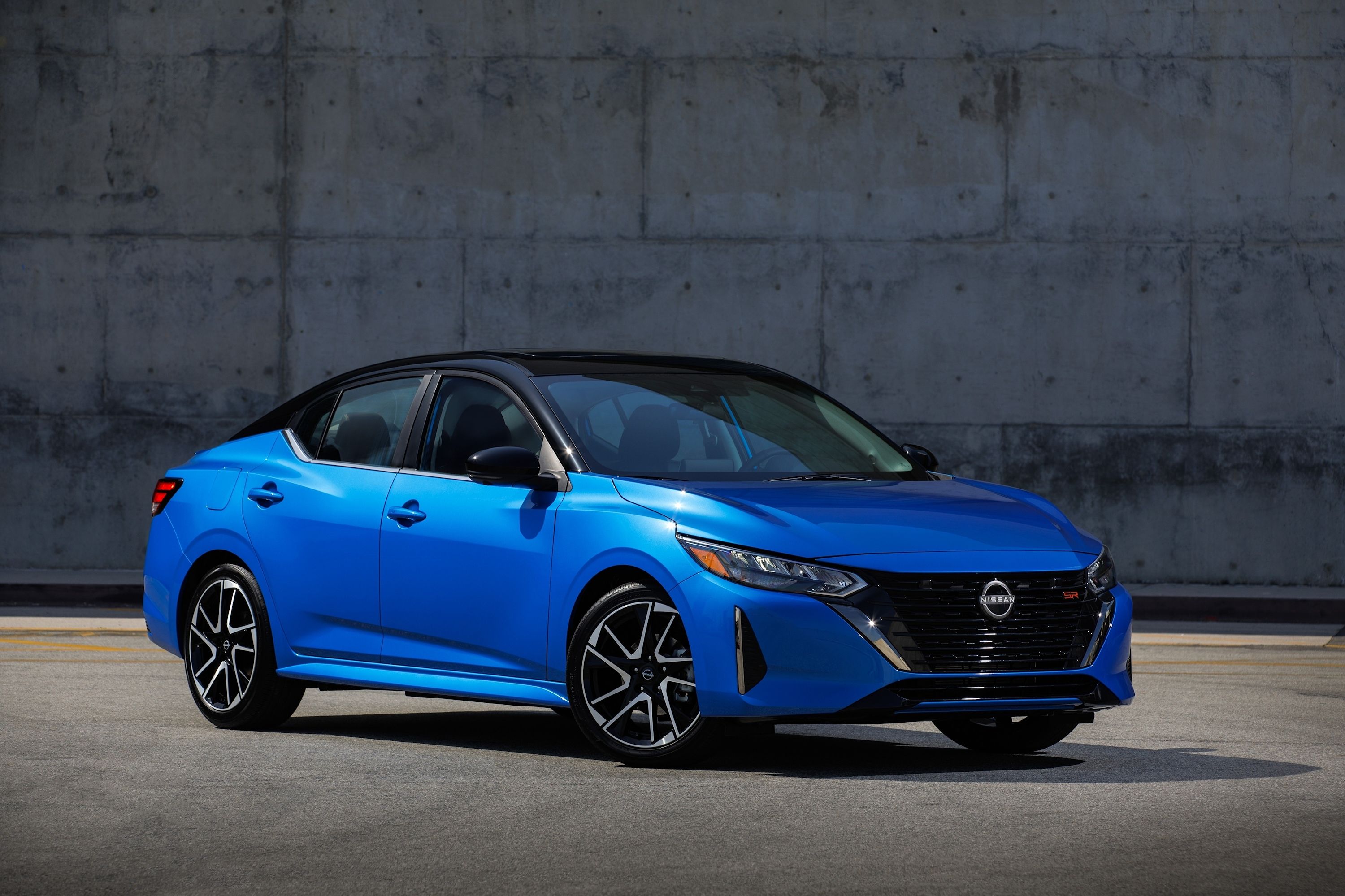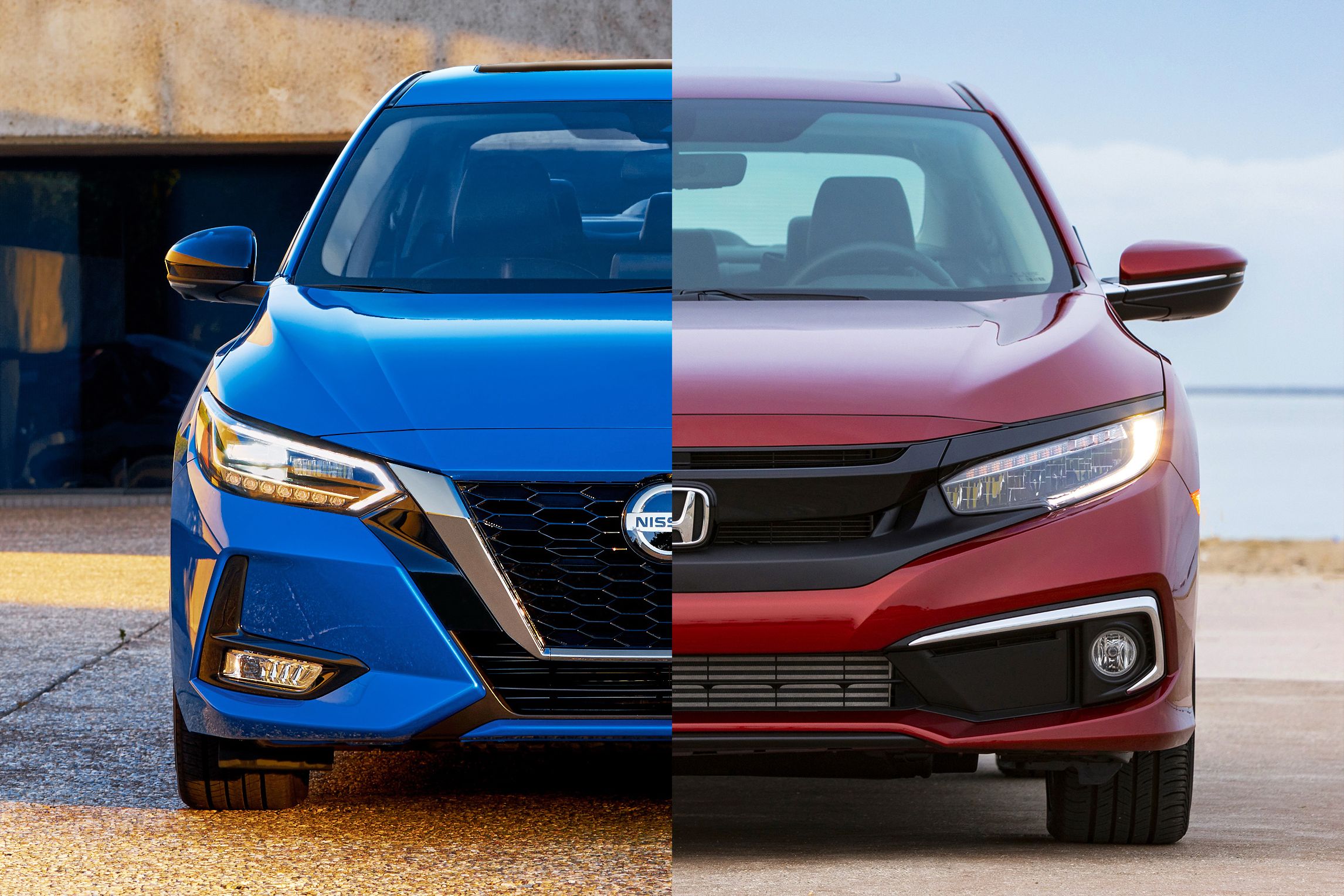
Nissan revealed the 2020 Sentra at this year's 2019 LA Auto Show, the compact sedan's first major redesign since 2013. This was long overdue, especially considering that a majority of its competitors surpassed the outgoing model in nearly every major category. The redesigned 2020 Nissan Sentra is supposedly ready to do battle against the current compact sedan segment leader, the Honda Civic sedan. For years, the Civic has been the segment benchmark and the current generation has won universal praise for its interior and exterior styling, driving dynamics, and 1.5-liter turbo-four engine.
The new Sentra comes to the fight with new styling inside and out of its own, along with a new engine and a host of standard safety features. It's still too early to know how the 2020 Sentra drives, but the sedan's specs are there for the world to see.
How does the new Sentra compare to the excellent Civic sedan, at least on paper? Let's find out.
Price
The 2020 Honda Civic sedan has a starting price of $20,550. The Civic LX is the base trim and it comes standard with a host of standard features such as LED daytime running lights, a 160-watt audio system with four speakers, Bluetooth streaming audio, and a fold-down rear seat.
Nissan has not announced official pricing for the 2020 Sentra, but the outgoing model began at $17,990. Chances are the redesigned model will cost a bit more but we doubt it'll exceed the 2020 Civic's MSRP. What we do know is that Nissan packed its new Sentra with standard features like Nissan Safety Shield 360, a suite of six advanced driver-assist systems including Automatic Emergency Braking, Rear Automatic Braking, and High Beam Assist. A total of 10 airbags are also standard.
If spending the least amount of money is your chief goal, then the latest Sentra will probably suit you best. Then again, it's worth your while to do an apples-to-apples comparison regarding the complete list of standard features. We're still waiting for that information from Nissan.
Power And Fuel Economy
Upon its reveal, the sole engine choice for the new Sentra is a naturally aspirated 2.0-liter four-cylinder with 149 hp and 145 lb-ft of torque. The Civic comes standard with a 2.0-liter of its own, good for 158 hp and 138 lb-ft of twist. Both engines are paired to CVTs, though the Civic does come with a standard six-speed manual. If you're willing to spend the money, the Civic can be optioned with a peppy 1.5-liter turbocharged four with a total of 175 hp and 162 lb-ft.
The Civic, when equipped with the base engine, returns 25/36/29 mpg city/highway/combined. Nissan and the EPA have not announced official fuel economy figures for the Sentra, but the automaker claims it is projected to offer improved stats over the outgoing model's 27/30/35 mpg rating.
Both sedans, however, have an independent rear suspension setup, something the Sentra previously lacked. Along with its new chassis, the Sentra is now better placed to battle the Civic in terms of driving fun.
Exterior
Some have argued that Honda designers didn't know when to lift the pen when styling this latest Civic. Others claim the 10th-gen Civic looks better than ever. Whatever your position, the general exterior dimensions for both sedans are very similar, so it's not worth your time taking a tape measure to either one. Both offer optional LED headlights, premium wheel designs, and a host of colors.
What we happen to like about the Sentra is that it can be optioned with a black roof to contrast with the exterior color. This so-called "floating roof" effect definitely adds some style to an already sharp-looking design. While the previous Sentra could be described as "frumpy," the new model has the design language from the larger Altima and Maxima, only shrunken. Thanks to a wider and lower stance and better overall dimensions, the Sentra is finally a great-looking sedan.
Interior
Without question, the new Sentra's cabin looks and feels more mature than the Civic's. It's almost Audi-ish with its circular vents above the HVAC controls. Also notice that while the Civic's gauges are angular, the Sentra has a classic-looking gauge cluster. It includes an analog tachometer and speedometer with a multi-function display in between. The Sentra's steering wheel is very sporty thanks to its flat bottom and relatively thin spokes; it feels more premium than the Civic's wheel.
The rest of the Sentra's cabin also comes across as more premium. Notice the Sentra's infotainment display, which is placed high up on the dash instead of being more integrated within like that of the Civic's. Both sedans get Apple CarPlay and Android Auto as standard. Although the Civic gets standard adaptive cruise control, the Sentra has blind-spot monitoring and rear cross-traffic alert as standard. You have to move to higher trim levels to get these on the Civic.
Another Sentra bonus: optional quilted leather seats. You can't get those on the Civic.
Verdict
Until Nissan provides full specs, pricing, and fuel economy figures on its new 2020 Sentra, it's difficult to offer a precise verdict between it and the Honda Civic. But there's no question the Civic was Nissan's benchmark vehicle when designing and engineering the Sentra. It will be interesting to see how they compare, especially in handling tests.
In general, you can't go wrong with either one. The Honda Civic is one of the best overall vehicles on the market today. It has been for years. The Sentra has also been around for quite some time, but it's never been this refined and good looking before. Nissan claims it is celebrating the reinvention of the Sentra, its best-selling US model of all time. Based on everything we see and know, the Sentra truly has been reinvented in all the right ways. The Honda Civic may have finally met its match.

